
14 minute read
Read All About It
THIS WEEK CAPE MAY Vol. XLVIII Number 3 MAY 22-JUNE 11, 2020 in
From the Director Our entire Cape May MAC staff is diligently working to resume our schedule of tours and operations in the face of this historic COVID-19 challenge. But we cannot get through it alone. Now more than ever, we need you to show how you’ve appreciated what Cape May MAC has provided culturally to enrich your life during our 50-year history, so that we can continue to do so for you and future generations of your family. Of course, donations are most welcome and appreciated. As are ticket purchases now, that can be used once we’re back in operation, for any number of Cape May MAC tours and events. Everything helps. And please don’t forget to patronize our local businesses in this issue, many of whom help support us not only through advertising but also as event sponsors. Seasonal businesses don’t have as much time to recover and they need our help, too.
Advertisement
DONATE TO MAC Jody Alessandrine
Director/CEO
THIS WEEK IN CAPE MAY
Published by Cape May MAC Ce l e b r at i n g H i s to ry ... En r ich i n g Li v e s
P.O. Box 340 • 1048 Washington St., Cape May, NJ 08204 • (609) 884-5404
Editors Jody Alessandrine • Mary Stewart
Designer ... Jean Barraclough For advertising information, contact JOE McLAUGHLIN, Advertising Representative (609) 224-6120 or (609) 884-5404, ext. 1-135 • jmclaughlin@capemaymac.org Copyright © 2020 Cape May MAC. All rights reserved. Reproduction in whole or in part without written permission is prohibited.
WWW.CAPEMAYMAC.ORG
Inside....
50 YEARS OF MAC......................................12 CAPE MAY LIGHTHOUSE............................9 CAPE MA Y MAC MEMBERSHIP.............32-33 CAPE MAY MAC’s MUSEUM SHOPS..........53 CAPE MAY MUSIC FESTIVAL.....................48 COMING ATTRACTIONS .......................72 -73 EMLEN PHYSICK ESTATE ..............................7 I L OVE CAPE MAY...................................... 51 SPRING CELEBRATION GARDEN TOUR...30 WORLD WAR II LOOKOUT TOWER............8 WEDDINGS & PARTIES ...............................35
CAPE MAY TIDBITS & VICTORIAN ODDITIES Cape May’s Stormy Past.................. 60 No Online Recipes? .......................... 16 Cool Fashion Statement ....................18 Sit Back & Relax.................................. 26 Playing My Song ................................44 Read All About It.................................. 4
5
INDEX TO ADVERTISERS Tours & Attractions ......................... 15 Services/Accommodations............20 Dining/Entertainment....................34 Shopping........................................50 ADVERTISER HOURS/SERVICES SUBJECT TO CHANGE. PLEASE CONFIRM BEFORE VISITING OR SHOPPING. WE APPRECIATE YOUR SUPPORT OF OUR LOCAL BUSINESSES!
Man of the House
PG. 6
The Iceman Cometh
PGS. 14-15
Cape May Ablaze
PGS. 22-23
The Old Congress Hall
PGS. 40-41
Man of the house
The architecture of the Emlen Physick house, Cape May’s only Victorian house museum, is known as Stick Style.
This style is characterized by an emphasis on horizontal, vertical and diagonal timbers that suggest the structural framework of the house. In reality, these “timbers” were not part of the framework, but were instead decorative pieces of lumber that were applied to the exterior. Often these pieces of applied timber were painted in a contrasting color to the main body of the house. Steep, irregular roof lines and an overall boxy and angular appearance are also trademarks of the Stick Style.
The fact that the Physick family chose
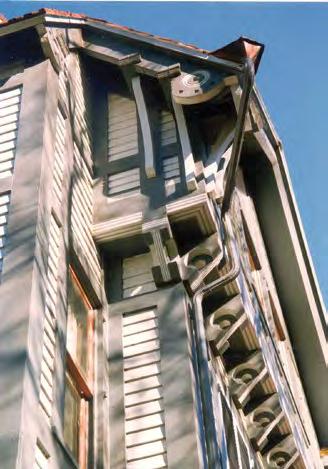
The Stick Style is characterized by wood construction with boxy projections, such as bays, wings and towers; asymetrical forms and roof lines; a grid work of raised boards, called “stick work,” overlaying the clapboarded walls; and simple decorative elements, often geometric in design
Architect Frank Furness 1839-1912
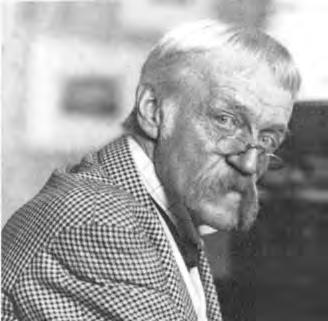
to build their home in the Stick Style says something about their personality. The Stick Style was seen as somewhat avant garde and eccentric. When most people were building their homes in the Italianate, Queen Anne, or Gothic Revival Styles, the Physicks instead chose the Stick Style.
The Physick House was designed by Philadelphia architect Frank Furness, who is now recognized as one of the country’s greatest Victorian architects.
Furness designed numerous buildings in Philadelphia and had a summer house in Cape May. It seems likely that the Physicks might have met Furness during one of his stays in Cape May. Furness’ trademark features included greatly oversized corbelled (upside down) chimneys, jerkinhead dormers, and “dog bone” porch brackets. All three of these elements appear on the Physick House.
The Physick House is currently closed due to Covid-19, but you can visit our website at www.capemaymac. org or click here for a virtual tour.
Time travelers welcome!
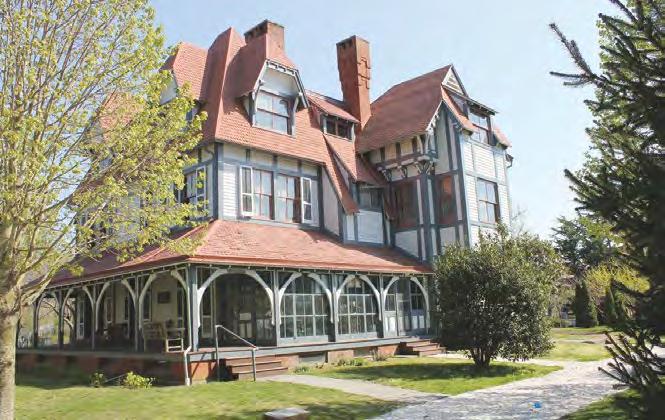

7
1879 Emlen Physick Estate Become a Cape May MAC Member and get FREE ADMISSION to the Emlen Physick Estate and the Combination Trolley/Physick Estate Tour
See page 32-33 for information or call 609-884-5404 Historic site administered by Cape May MAC 1048 WASHINGTON ST. ORDER TICKETS ONLINE AT CAPEMAYMAC.ORG TAKE A VIRTUAL TOUR OF THE PHYSICK ESTATE! THE PHYSICK ESTATE IS CURRENTLY CLOSED but will re-open under Stage 2 of the Governor’s 3-Stage Strategy (date tbd)
CHECK OUR WEBSITE FOR UPDATES TAKE A VIRTUAL TOUR BY CLICKING ON THE LINK AT THE BOTTOM OF THE PAGE
Amid this historic COVID-19 challenge, we need your help. We need you to show how much you’ve appreciated what Cape May MAC has provided culturally to enrich your life during our 50-year history, so that we can continue to do so for you and future generations of your family. Please consider purchasing advance tickets that may be used when we re-open.
READ MORE ABOUT THE PHYSICK ESTATE This Old House PRESERVATION OF THE PHYSICK ESTATE
Each year, our tour of the Physick House Museum highlights a particular aspect of Victorian life and culture. This year marks Cape May MAC’s 50th Anniversary, and our tours will focus on the Physick House itself. It is fitting, since this is where Cape May MAC began, in its efforts to save the house from the wrecking ball. You will learn of the mansion’s years as a grand residence for the Physick family, to its tragic decline and near demolition and, finally, to its rise as a fully-restored historic landmark. Come join us to learn the compelling story of its life.
The first floor of the Physick House Museum is fully accessible
WORLD WAR II LOOKOUT TOWER Fire Control Tower No. 23 Museum & Memorial
Sunset Boulevard, Lower Township near Cape May Point GPS: 536 Sunset Blvd., Cape May Point

Climb this fully restored tower and learn about the “war at the shore” and the defense of the Delaware River and Bay from enemy invasion!
CAPE MAY MAC MEMBERS GET IN
FREE! See pages 32-33
The boardwalk, lined with interpretive panels, the All Veterans Memorial on the deck at the base of the Tower and the entry level are all fully accessible.
$ 6 for adults; first child FREE with paying adult, $ 3 each additional child, $ 3 Veterans; Active Military Free
Historic site administered by Cape May MAC
Restoration has been undertaken by Cape May MAC in conjunction with the New Jersey Department of Environmental Protection, Division of Parks and Forestry. Funding for its restoration was provided by the New Jersey Historic Trust, the New Jersey Historical Commission, the Casino Reinvestment Development Authority, a Save America’s Treasures Grant, and a Small Cities Community Development Block Grant administered by the New Jersey Department of Community Affairs.
Cape May Lighthouse
Located in Cape May Point State Park Lighthouse Avenue, off Sunset Boulevard GPS: 215 Lighthouse Ave., Cape May Point
CURRENTLY CLOSED Will re-open once the State Park Buildings are permitted to do so (date tbd) Check our website for updates TAKE A VIRTUAL TOUR
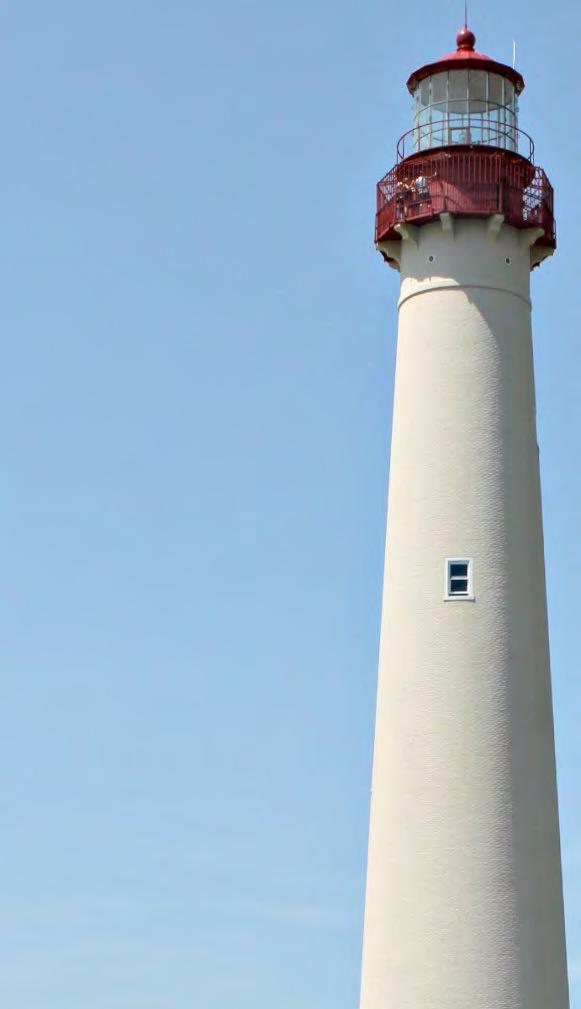
Climb 199 steps in this 1859 structure to the watch gallery (just below the lantern itself) for a panoramic view of the Jersey Cape & Delaware Bay!
Tower admission: $ 10 adults $ 5 children (ages 3-12)
A fully accessible Visitors’ Orientation
Center and Museum Shop carrying souvenirs, books and maritime items are located in the Oil House CAPE MAY MAC MEMBERS GET IN FREE! See pages 32-33
The state park offers a Hawk Watch platform and nature trails, as well as a museum with live reptiles and nature displays, and there are covered pavilions and access to the beach (swimming is not allowed). You can also see the World War II bunker on the beach. Rest rooms are available in the park and there is ample free parking.
Restoration has been undertaken by Cape May MAC in conjunction with the New Jersey Department of Environmental Protection/Division of Parks and Forestry, and was funded in part by the New Jersey Historic Trust, the ISTEA program administered by the NJ Department of Transportation, the Cape May County Open Space program and the 1772 Foundation. Historic site administered by Cape May MAC
$ 2.00 OFF! Good for the Entire Group* *Sponsored trips excluded Salt Marsh Safari on the Skimmer Back Bay Birding and Wildlife Cruise Enter code “TWICM2off” when ordering tickets online

Salt Marsh Safari on the Skimmer New Location/Same Amazing Experience!
Now sailing from South Jersey Marina in Cape May
(just south of the Lobster House) Visit nesting ospreys, gulls and terns. Learn about horseshoe crabs & other marine life. Fun! Educational!
Calm waters & expert naturalists! LIMITED SPRING SCHEDULE: Please visit www.skimmer.com to view our schedule and new Covid-19 policies
609-884-3100
INFO & RESERVATIONS www.skimmer.com
Hereford Inlet Lighthouse A Beacon Since 1874
A working lighthouse & museum • Self-Guided Tours • Picturesque Gardens • Special Events • Overlooking Scenic Hereford Inlet
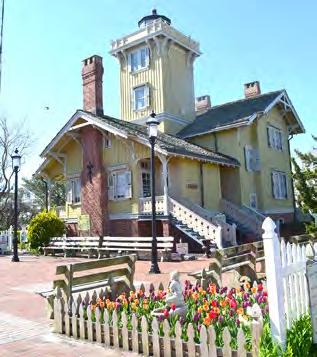
Check our website for re-opening date
111 N. Central Ave. North Wildwood, NJ 609-600-1561 www.herefordinletlighthouse.com
It’s VIRTUAL! May 23 & 24 Find out what the neighborhood birders are so excited about. Virtual field trips, workshops and keynotes right in your living room. Click on this ad to learn more or call Deb Shaw, 609-400-3836 • www.njaudubon.org
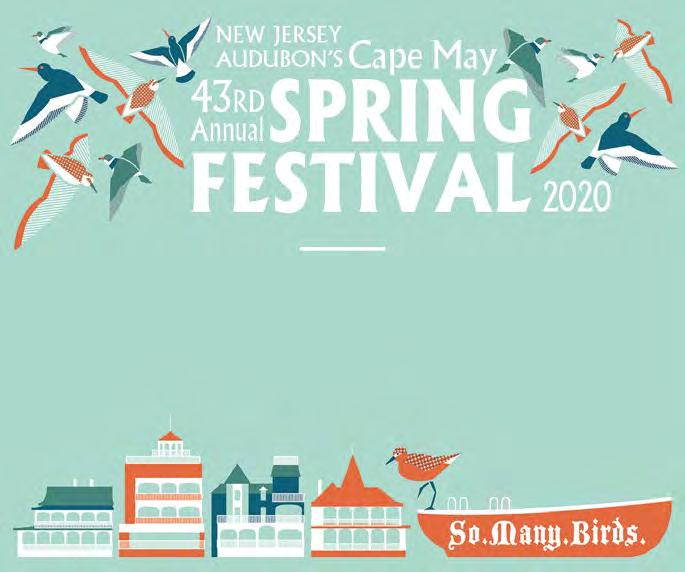

50 Years of MAC
The 50-year journey of the Mid-Atlantic Center for the Arts & Humanities (MAC) began in 1970 when a small group of dedicated neighbors joined together to save the 1879 Emlen Physick Estate from the wrecker’s ball. Over the years, the organization’s efforts have continued, restoring and opening both the Cape May Lighthouse and the World War II Lookout Tower.
Those years also included thousands of special events and tours, all of which contributed to make Cape May MAC Cape May’s leader in heritage tour ism, educational outreach, historic preservation and cultural enrichment.
Join us as we remember those 50 years in words and photos at 2020’s
ANNIVERSARY CELEBRATION EXHIBIT at the Carroll Gallery in the Carriage House, 1048 Washington St.
Currently closed, but will be open through Nov. 1 once the Physick Estate re-opens
For more information, call 609-884-5404 or visit www.capemaymac.org
CELEBRATING HISTORY. ENRICHING LIVES.
Museum
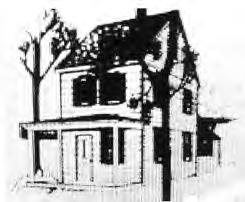
A hidden treasure in the heart of Cape May City
Located next to Cape May City Hall, the Colonial House (c 1730), was originally a tavern and the family home of Revolutionary War Patriot Memucan Hughes. The front room features a tavern room. Other rooms open to the public in this unsung survivor from Cape Island’s very beginning depict a colonial era cooking/eating room. A fine example of vernacular architecture and colonial living back in the days.
Donations benefiting the preservation of the house are most appreciated
Visit our website at www.capemayhistory.org
Funding has been made possible in part by the New Jersey Historical Commission / Department of State, and the Cape May County Board of Chosen Freeholders through the Cape May County Department of Tourism, Public Information and Culture & Heritage.
653½ WASHINGTON ST.
(Next to Cape May City Hall) Contact us at 1730colonialhouse@gmail.com The Greater Cape May Historical Society A non-profit and stewards of the Colonial House
Supported in part by a grant from the New
Jersey Department of State, Division of
Travel & Tourism. www.visitnj.com
The iceman cometh
Despite this year enjoying one of the mildest winters (so far) in memory, it wasn’t always so. And it’s a good thing, too, because back in the Victorian days of Cape May, residents counted on that cold weather to deliver something we take very much for granted today: Ice.
In the days before refrigeration, perishable foods were stored in ice boxes. The Physick family had iceboxes in the basement and in the refrigerator room at the back of the house and, ne xt time you visit, you can see one of these ice boxes just off the hallw ay past the kitchen. I’m also sure that many of you have won dered where the ice came from and how they kept it solid throughout the year.
Ice was gathered during the annual ice harvest, which usually took place in January or February, after the ice was about 18-20 inches thick. The harvest was quite an event and was much an ticipated by young and old alike. John B randow, from upstate New York, worked many years during the ice harvest. National Geographic once recorded his remembrances of the ice harvest.
“The winters were long. You could count on six months of winter, usually. Coming right in the middle of the win ter, ice harvesting season was anticipated with enthusiasm, really. And it was a get-together – a place where friends met and talked and lunched together. We put in nine-hour days and it was pretty much constant work. And nobody seemed to shirk it; they rather enjoyed it… the ice harvest was a week or 10 days of constant involvement and camaraderie.”
Although, Mr. Brandow’s experiences come from the 1930s, the anticipation and process of the ice harvest w ere the same as the Victorians experienced decades earlier.
M ost of the ice harvested in the Northeast came from upstate New York, and the New England States. The ice was commercially harvested from ponds and rivers, stored in icehouses,
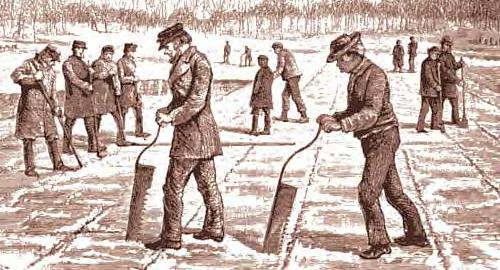
and shipped via railroad to urban areas. The first step of the process was cutting the thick ice into cakes with the help of a saw plow harnessed to a horse. Of course, the ice had to be thick enough to hold the weight of a horse, the saw, and a team of men. Later, the horse was replaced by the automobile. Once deep grooves were cut into the ice by the saw plow, men with large coarsetoothed cross-cut saws would cut the rest of the way through the ice and set it free in large cakes. Each cake mea sured about 12 by 18 by 18 inches, and w eighed about 150 pounds.
The cut cakes of ice were floated across the water to a conveyor belt, which moved them up to the top of the icehouse to a chute. Gravity pro pelled the large cakes down the chute and in to the icehouse. Men stationed
at the base of the chute would harpoon the ice with a long pike and swing it into position in the icehouse. The icehouse would fill up in seven or eight days of steady work. Thick layers of sawdust were packed under, around, and over the blocks of ice, so that each block had its own insulating blanket. The trick to keeping the ice from melting was dry sawdust. Once the saw dust got wet, the ice would begin to melt very quickly. Therefore, sawdust was replaced as it became damp, thus slowing the melting process. Once the icehouse was filled, the doors were shut and not reopened until warmer weather when the ice was needed.
Ice was transported from these large icehouses by train to urban areas, like Philadelphia. From the icehouses in these urban areas, the ice was moved again to the rural parts of the country and stored in local icehouses. The Phys ick family probably got its ice from the loc al ice house.
When the winter was cold enough, ice would be harvested locally (from Lily Lake). When the weather didn’t coop erate, ice was shipped down from the N orth and was stored in the local ice house. As Dr. Physick and his family desired ice, they would simply get a block
Tours & Activities
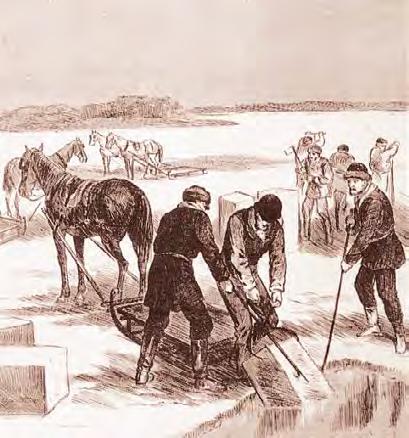
or two from the local icehouse. In 1901, there was an icehouse located on Washington Street. Called the Knickerbocker I ce and Coal Company, the building stood at 624 Washington St. Ice was really only needed when the weather was warm (maybe May to September or October). During the rest of the year, items that the Physick family stored in the basement would stay cold enough to prevent them from spoiling.
So, next time you go to the refrig erator and take advantage of your automatic ice maker, remember how precious and valuable that ice was during Vict orian times, and how much work went into getting it to your glass.


